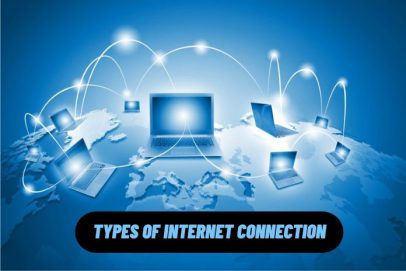Did you know that a default download speed of 10 gigabits – that’s 10,000 megabits per second – or higher can be yours with a fiber-optic internet service like Orange fiber
However, fiber-optic internet is not the only internet connection type there is. This guide enumerates your top internet connection options.
1. Dial-Up Internet
Dial-up internet feels (and is) like a relic from the past. It provides internet connectivity through a standard telephone line.
Specifically, dial-up uses a modem to convert digital data into analog signals, and phone lines transport them through the same audible frequency used for voice calls. This is why you can’t use the phone and dial-up internet simultaneously.
Dial-up internet speeds peaked at 56 Kbps, so dial-up won’t win you any races. Think of it this way. If you used dial-up internet today to book a Saadiyat Island hotel stay, you’d probably need to wait at least half an hour to an hour to complete your transaction.
Indeed, dial-up is slow, especially compared to modern broadband connectivity options like DSL, cable, and fiber-optic internet. Yet, its simplicity and the widespread availability of telephone lines made it a ubiquitous presence before other internet options became available.
Also Read: What Is IPTV?
2. DSL Internet
Digital subscriber line (DSL) represents a leap from the traditional dial-up connection. Like dial-up, it uses telephone lines but connects to the internet at a different frequency instead of the phone line’s audible frequency. Thus, DSL does not interrupt telephone calls, and vice versa.
DSL has three variants, and they are:
- Asymmetric DSL: Asymmetric DSL or ADSL provides faster downloads (up to 20 Mbps) and slower uploads (up to 1.4 Mbps).
- Symmetric DSL: Symmetric DSL or SDSL provides balanced upload and download speeds.
- Very-High-Speed DSL: Very-high-speed DSL or VDSL is the fastest DSL type. It uses high frequencies to deliver up to 52 Mbps download speeds and up to 16 Mbps upload speeds. A newer VDSL version can deliver incoming and outgoing speeds of up to 100 Mbps.
DSL is a good option in areas where cable or fiber connections are not available.
Generally, it provides higher speeds than satellite internet, although speeds degrade the farther away you are from a DSL access point. It should also be easy to obtain since it uses existing landline telephone infrastructure.
3. Satellite Internet
Satellites orbiting the Earth can provide internet connectivity. It is ideal for rural areas that lack the necessary wired infrastructure for cable, fiber, and DSL internet.
Internet service providers deliver the service by sending satellites into orbit (or making arrangements with organizations that own satellites). These satellites communicate with ISP-provided satellite dishes in end-users’ homes to deliver internet connectivity.
Satellite internet is typically pricier than cable, fiber, and DSL internet. It is also usually slower than DSL. That said, some modern satellite providers can now provide high-speed, low-latency connections that may deliver a better experience than DSL internet.
4. Cable Internet
Cable internet is to cable televisions as DSL is to telephones. It delivers internet connectivity via the coaxial cables that your cable TV service uses. It’s a common type of broadband connection, offering speeds up to 940 Mbps for downloads and 50 Mbps for uploads.
Generally, cable internet is faster and better than DSL. Like DSL, it is ubiquitous due to the widespread availability of cable TV infrastructure. It can also be cost-efficient since it usually comes bundled with cable TV. However, its shared network can lead to congestion and slower speeds during peak times.
5. Fiber Internet
Fiber internet, or fiber-optic internet, is the best broadband connection type, capable of speeds up to 10 Gbps. It uses fiber-optic cables, bundles of optical fibers slightly thicker than human hair, to transmit data.
However, whereas traditional broadband technology transmits data as pulses of electricity, fiber-optic internet transmits data as pulses of light. Thus, it is very efficient; in fact, fiber internet data can travel at approximately 70% the speed of light.
Additionally, fiber-optic cables are not susceptible to electronic interference. They are also weather-resistant. Both these things ensure the reliability of fiber internet connections.
Fiber internet delivery involves two main components, which are:
- Optical fibers: These are bundled into cables, and light pulses of data travel through them at high speeds.
- Optical network terminal: The optical network terminal converts light pulses into electrical signals. This conversion can take place in the end-user’s home (i.e., pure fiber connection). The terminal can also be shared by an entire block or area, in which case, the last mile of data connection uses copper cables instead of fiber-optic cables.
Fiber internet has the following advantages:
- Unparalleled speed: Fiber internet provides unmatched download and upload speeds. It is the best internet connection type for heavy internet use, like high-definition streaming, online gaming, and large file transfers.
- Reliability: Fiber internet is less prone to outages.
- Symmetrical speeds: Unlike other broadband services, fiber internet can provide equal upload and download speeds.
While fiber offers top-tier speeds, it can be costly. However, the higher price point should be worth it if you need its reliability, low latency and high speeds.
The main drawback of fiber internet is limited availability, especially in rural areas. This is due to the logistical challenges of laying fiber-optic cables.
Link Up: Choose The Internet Connection To Fit Your Lifestyle
There are many internet connections types and Dial-up is obsolete, but there was a time when you would have been grateful for it. There’s DSL internet for rural areas, satellite internet for inaccessible locations, cable internet wherever there’s cable TV, and fiber internet – the best and fastest broadband internet – for those lucky enough to be where there’s fiber-optic internet service.
Also Read: The 5 Things You Should Know Before Using A Free VPN

